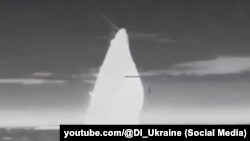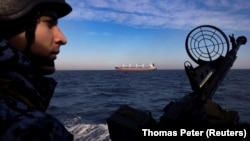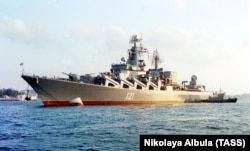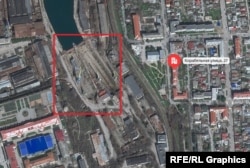The grainy black-and-white video showed what appeared to be a fast-moving speedboat bobbing on the nighttime waves, swerving back and forth as it approaches a much larger warship. The ship then explodes spectacularly, and the nearly 3-minute video ends with a vessel seen rolling onto its port side just before it sinks.
The speedboat was in fact a Ukrainian-designed unmanned maritime drone packed with explosives, known as the MAGURA-V. The warship purportedly was the Tsezar Kunikov, one of just a handful of heavy landing ships in Russia's Black Sea Fleet. It sank off the southern coast of Crimea, the Ukrainian peninsula Russia seized 10 years ago. The fate of the ship's crew, estimated at around 70, is unclear.
One day after, the admiral in charge of the Black Sea Fleet was reportedly stripped of his command.
The Tsezar Kunikov is one of nearly two dozen Russian warships that Ukraine has seriously damaged or outright sunk since Russia began its full-scale invasion on February 24, 2022.
Prior to its sinking, Oryx, a Dutch open-source website known for verified tallies of Russian and Ukrainian equipment losses, put the figure at 21 warships and one submarine. Ukraine's general staff has a slightly higher count: 24 Russian ships and one submarine.
That works out to approximately a third of the entire fleet, which numbers around 74. Those figures do not include smaller craft such as shallow-draft coastal patrol boats or auxiliary vessels.
No matter how you count it, it's an extraordinary set of naval losses inflicted by a country that currently does not have a navy. Naval and military experts around the world have taken note.
"Ukraine's success in the Black Sea this year certainly came as a surprise to many of us. At sea, the Ukrainians have proven to be much more technologically and tactically innovative than the Russians have," said Michael Petersen, director of the Russia Maritime Studies Institute at the U.S. Naval War College, in Newport, Rhode Island.
"The daring innovation they have displayed is in contrast to the [Russian] Black Sea Fleet, which has proven to be extremely risk averse and lacking in imagination," he said.
"Ukraine has prosecuted a classic asymmetric campaign against what was a significantly stronger opponent," said Mike Plunkett, senior naval platforms analyst at Janes, a defense intelligence research company.
Russia "has gone from being the indisputable maritime power in the Black Sea -- on paper at least -- to being pinned back into the eastern portion and unable to exert sea control over the region," he said.
Barrages And Blockades
Prior to February 2022, Ukraine's navy was largely made up of Soviet-era surface ships and some onshore infrastructure that it inherited in the late 1990s when Kyiv and Moscow agreed to divide up the Soviet Black Sea fleet.
The two countries' fleets were housed close to one another in Crimea, including at the peninsula's historic main port, Sevastopol.
Ukraine's budget problems, along with corruption in military and civilian procurement, however, meant its fleet, including combat and auxiliary ships, could barely stay afloat and was perennially underfunded.
After Russia seized Crimea in 2014, Ukraine moved its serviceable fleet, including four corvettes and its flagship, the frigate Hetman Sahaydachniy, to the port of Odesa, to the west.
Ukraine began losing access to its other major ports, Berdyansk and Mariupol on the Sea of Azov, in the run-up to Russia's invasion. Russia had imposed what amounted to a naval blockade of the Sea of Azov, using the Crimea Bridge as a gateway to choke passage through the Kerch Strait, the only waterway linking it to the Black Sea and the world beyond the Bosphorus.
With the onset of the invasion, Ukraine scuttled the Hetman Sahaydachniy in Mykolayiv, a port on the Pivdenniy Buh River, where it was undergoing repairs. As many as a dozen other Ukrainian ships were damaged or sunk around the Black Sea.
In the end, Russia imposed a virtual blockade of Ukraine's ports, including the largest one still under its control, Odesa, with surface ships blocking foreign cargo ships from loading up and exporting Ukrainian grain. Global grain markets reeled, and UN officials warned of potential famine in some Mediterranean and African countries that heavily rely on Ukrainian grain.
The blockade worsened for Ukraine and for other Black Sea nations after floating land mines began to drift, some breaking free of their moorings. Kyiv and Moscow have blamed each other for allowing the mines to drift.
Russia used its Black Sea surface and submarine fleet -- around 80 vessels in total, according to Ukrainian estimates -- to fire some of the missiles that barraged Ukrainian cities and towns, terrorizing the population.
The Russian fleet's flagship, the guided missile cruiser Moskva, played a leading role in the amphibious assault on Snake Island. A small garrison of Ukrainian border guards stationed on the strategically located island about 140 kilometers south of Odesa were captured Russian forces on the first day of the full-scale invasion.
Nearly two months later, on April 13, as the Moskva steamed east of Snake Island, it was hit by what turned out to be two land-launched Neptune anti-ship missiles. The ship sank less than a day later. At least 18 sailors were killed, though outside estimates say the death toll was likely significantly higher.
It was the largest Russian or Soviet warship to have been sunk since World War II.
"Just because your opponent doesn't have a meaningful navy, do not assume you have complete freedom of movement and action at sea," Plunkett said.
Destroyed Dry Dock
For many experts, Ukraine's sinking of the Moskva showed ingenuity and a willingness to take risks.
"They tried something, it worked even better than they hoped, with the Moskva sinking," said Dmitry Gorenburg, a senior research scientist at the Center for Naval Analyses, a think tank based near Washington, D.C., "and then they said, 'Oh great! And let's build on that!' and they've been working on that for the last two years."
"I doubt the Ukrainians ever expected to hit, let alone sink Moskva, but the fact they did made their point in the clearest way possible," Plunkett said. "It had the desired effect as well, with Russia pulling its surface fleet back into the central Black Sea and away from Ukraine."
About three weeks before the sinking of the Moskva, on March 24, 2022, a landing ship called the Saratov exploded while docked in the Russian-occupied port of Berdyansk. Ukraine later revealed it had used a short-range Tochka-U ballistic missile to target the ship.
Two other landing ships that were docked close by at the same time -- the Tzesar Kunikov and the Novocherkassk -- managed to escape with minimal damage.
Other Western-supplied weapons have further supported Ukraine's creativity.
In May 2023, Britain announced it would supply Kyiv with Storm Shadow cruise missiles, an air-launched missile with a range of around 250 kilometers. France supplied a French-version of the missile, known as SCALP.
The missiles were employed to hit several bridges in Russian-occupied parts of Ukraine. But on September 13, Ukraine fired a series of missiles at a dry dock repair facility in Sevastopol, seriously damaging, and possibly destroying, the landing ship Minsk and a submarine, the Rostov-on-Don. The port's repair facilities were also badly damaged, posing complications for repairing the fleet's larger warships and submarines.
Nine days later, Ukrainian jets fired multiple Storm Shadows at the headquarters of the Black Sea fleet in Sevastopol. Ukrainian authorities claimed dozens of officers were killed or wounded in the strike. Russia has never confirmed the toll.
On December 26, the Novocherkassk, which had escaped the March 2022 attack on Russian vessels in occupied Berdyansk, was hit and reportedly sunk while berthed at a repair dock in the eastern Crimean port of Feodosia. Ukrainian officials suggested Storm Shadow or SCALP missiles were used in the attack.
The ship reportedly had a crew of 77 at the time of the sinking. As of February 12, 33 sailors remained missing, according to Russian war bloggers. The Defense Ministry has released no official tally.
Enter The Unmanned Sea Drone
Ukrainian creativity also gave rise another potent naval weapon: the unmanned maritime drone, essentially a high-speed, pilotless boat packed with explosives. Ukrainian authorities publicly announced the push to develop such weapons in November 2022.
The first Russian vessel believed to have been targeted with a maritime drone was another heavy transport landing ship, the Olenegorsky Gornyak. On loan from the Northern Fleet, the Gornyak was seriously damaged on August 4, 2023, when it was targeted in Novorossiisk, a Black Sea port about 425 kilometers east of Sevastopol.
Three months later, Ukraine's military intelligence claimed that two other landing ships were damaged and possibly sunk near Chornomorske, on Crimea's west coast.
February was a particularly cruel month for the Russian Black Sea Fleet. On February 1, the guided missile corvette Ivanovets was attacked and sunk as it stood at anchor near the western Crimean settlement of Okunivka. Grainy black-and-white video released by Ukrainian military intelligence shows the Ivanovets listing and then sinking below the surface, stern up. A spectacular series of explosions suggests the ship's magazine detonated.
Ukraine followed up 13 days later with the purported sinking of the Tsezar Kunikov, which, like the Novocherkassk, had escaped the March 2022 attack on Berdyansk, If confirmed, the Kunikov would be the fifth such landing ship -- known as the Ropucha-class -- to have been put out of commission by Ukraine.
The Kremlin declined comment on the sinkings, deferring to the Russia's Defense Ministry, which has said nothing.
On February 15, multiple Russian war bloggers reported that the commander of the Black Sea Fleet, Admiral Viktor Sokolov, had been stripped of duties.
The head of Ukraine's military intelligence agency, Kyrylo Budanov, said later that the homegrown Ukrainian drone called the MAGURA-V was responsible for the attack.
'The Russian Navy Is Far From Beaten'
Russia's other fleets -- the Northern Fleet, the Pacific Fleet -- remain potent tools for the Kremlin. Russian ships have played a key role in ferrying personnel and weaponry to Syria, where Russian forces helped tip the scales in favor of the Syrian regime of Bashar al-Assad.
Its submarines, particularly its nuclear-capable ballistic missile ships, are powerful, stealthy, and arguably a match for the other submarine fleets, including the U.S. Navy.
"For all of its losses since the start of the war, the Russian Navy is far from beaten, and still presents a significant challenge to NATO navies," Plunkett said. "So no, the Russian Navy is far from dead, even as it has suffered in the Black Sea."
The loss of five landing ships like the Tzesar Kunikov would sharply limit the Russian military's ability to ferry heavy equipment like tanks or armored personnel carriers, as well as men and supplies, to shorelines on the Ukrainian mainland and -- a bigger problem for Russia -- to Crimea. If the bridge linking Crimea to Russia is destroyed or damaged, that poses a potential risk for Russian forces on the peninsula.
But while the Russian fleet's losses may have curtailed its operations, they certainly have not ended its threat.
On February 15, at least two sea-launched Kalibr cruise missiles were fired at Ukrainian targets from somewhere near Novorossiisk, according to Ukraine's military.
Still, the Ukrainian achievements are both a moral victory and a broad tactical victory: Russia's Black Sea operations have been markedly affected, forcing the fleet to sail further away from Crimea and the shores of mainland Ukraine.
"Ukraine's success at sea has little effect on the course of the ground war, and it certainly won't win the ground war. But it has created an incredibly important economic lifeline that can only offer Kyiv a greater chance at holding out longer," Petersen said.
Using sea-launched cruise missiles like the Kalibr, which has a 1,500-kilometer range, Russian ships can still pound Ukrainian land targets, said Plunkett, of Janes. But the ships have to fire from further away, giving Ukrainian defense extra time to warn civilians and track the missiles.
"Ukraine has prosecuted a classic asymmetric campaign against what was a significantly stronger opponent," he said. "Ukraine identified weaknesses in the Russian operations and then systematically and consistently applied pressure to them."
And the significance is not just limited to the Black Sea. In the Red Sea, cargo ships have been attacked and threatened by Huthi rebels in Yemen, prompting U.S. and British warships and fighter jets to respond, firing on multiple targets in Yemen.
The Huthis don't have a navy.
In Taiwan, which a growing and increasingly forceful China considers to be a renegade province that will eventually be reincorporated into the Chinese state, experts say military planners are also likely watching closely for tips and tactics about how to thwart a possible Chinese amphibious invasion one day.
"Implications elsewhere are significant," Petersen said.





